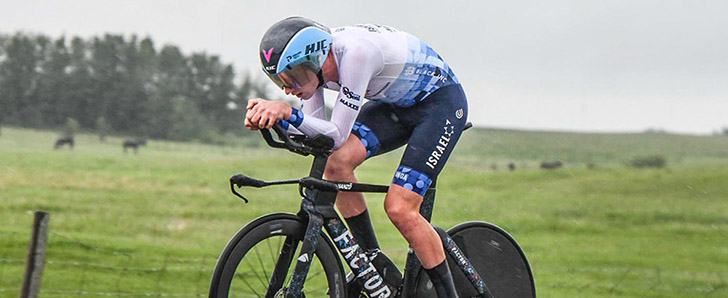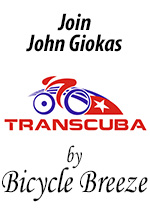June 29/07 1:58 am - Specialized 2008 Road Product Launch
Posted by Editoress on 06/29/07
'Tis the season for 2008 product launches. We have just finished with the Specialized Road launch, up in the mountains on the outskirts of Madrid, Spain (the Mountain Bike launch is next week, and we will have info on that, then). Besides the obvious cachet of getting to fondle all the new stuff and ride in the beautiful countryside around the town of Navacerrada, the Specialized launch is, well, special.
First, the company always has lots of cool stuff to play with. Second - and more important - this is a company of bike enthusiasts. On the rides you will be next to company founder Mike Sinyard, who will chat about his vision for the company. Next, you can slide back a few spots and talk with the engineer who designed the helmet you are wearing. Then, at dinner, Specialized staff will seriously discuss the situation with doping, or trail access, or getting more women into the sport. I always come away revitalized, despite travelling to Europe and back for as little as 72 hours...
We were also treated to the world premier of the Specialized Tour de France ads. They will show up on TV in 65 countries on July 7th (the day the Tour starts). Yes, Canada will see them. All we can say is that they are really cool, one features Tom Boonen and the other Paolo Bettini.
For 2008, Specialized, as always, has many interesting and innovative new products or upgrades, which I will get to in a minute. However, from my perspective, the most interesting new offering from Specialized isn't a product at all - it is a service, called BG F.I.T.
BG F.I.T.
Photos
Specialized has been focussed on proper bike fit and designing components to make riding more efficient and enjoyable for over five years with their Body Geometry line of shoes, clothing and hard parts. Now, they are taking it to another level with the introduction of the BG F.I.T. program.
Essentially, Specialized dealers are being trained and provided with software and hardware that will allow them to perform a complete customized fitting service for bike owners. The complete fit will take 2-3 hours, and include on and off-bike testing.
After starting with full body measurements, the rider is tested for flexibility and range of motion. They are then set up on their bike on a trainer and start cycling. After preliminary adjustments, and 'eyeball' analysis (called 2D BG F.I.T., for 2 Dimensional) a very good fit can be achieved - I had this done last year at the Specialized launch, and it was definitely effective.
However, Specialized is now rolling out 3D Advanced BG F.I.T. The biggest difference is that the fitting process also adds two video cameras to analyze position and pedaling stroke from both the side and the front. The system is hooked up to a computer and the video is streamed live on a split screen, with software which allows the fitter to track knee and leg motion dynamically as the rider pedals, and identify problems with the pedal stroke.
Normally, what is wanted is to have the knees - as viewed from the front - to track straight up and down; many, many of us tend to describe more of a figure-8 for one or both legs. This is not only inefficient, but can cause or accentuate) knee problems. Now that such abnormailities can be tracked dynamically, the fitter can make adjustments and then see the effect immediately on the computer screen.
Specialized is just launching the program now, and will offer it to dealers through their SBCU (Specialized Bicycle Components University). The full program requires both training and an investment in the software and hardware, but dealers are are already having great success with the 2D program.
Larry Koury, Managing Director of Specialized Canada, says that they will be training retailers in Canada by August, and expect to have the full 3D program in selected key shops across Canada by September (barring any unexpected delays in receiving the final software).
Now, the cost. Koury says that for the full 2.5-3 hour fitting process, customers can expect to pay anywhere from $150-$300, depending upon the complexity of the fit. Of course, if you are buying a Specialized bike at the time, some or all of the fee could potentially be waived. If you already have a bike (Specialized or not), the fitting will be available for the fee. The system is available for Road, Mountain and Triathlon style bikes.
To my mind, this is a long-overdue service, and the price is in line for what you would expect for any hands-on, time consuming process. Specialized is stressing that this is not just for the competitive racer - anyone who wants to enjoy riding their bike more will benefit from the service. I agree.
We will update you when the program rolls out and is at the retailers.
What's New for 2008
Photos
Now, onto the hard stuff...
In bikes, there are three major innovations - triathlon, high end road and women's cycling. First triathlon and time trial. The Transition tri / TT bike has been totally reworked for 2008 and, according to tri writers at the launch, the project has been a huge success. The bike was ridden by numerous testers on an 80 kilometre loop with a Category 1 climb, with no problems. Specialized says that it is the fastest bike that they have ever produced. It also meets all UCI regulations for time trial use.
The frontal area has been reduced dramatically, with an integrated fork, front and rear brakes, redesigned tubing and chainstays. Of course, cables are routed internally but, in a smart move they enter the frame at the top of the top tube instead of the sides, to reduce frontal area even more (a fourth hole for SRM routing is included, and each hole is bonded to hosing which runs through the frame - no fishing for cables). The design is available with straight or setback seat posts and comes with an S-Works stem with multiple angle settings, to cover a wide range of rider preferences. There are multiple models, headed by the Quick Step pro version, which will retail for $8000+ in Canada. More affordable versions (or the frameset, with fork, brakes, crank, stem and seatpost) will also be available. It will come in four sizes, and weigh 1500 grams with all attached parts (fork, seat post, stem).
In the high end road department, all bikes have received tweaks, but the introduction of the top-of-the-line Tarmac SL has been superseded with the Tarmac SL2 (the SL will remain in the lineup). Specialized says that they have been working closely with the Quick Step-Innergetic team, and specifically Tom Boonen and Paolo Bettini, to bring these top pros the bike they want.
The result is a bike that is lighter (6.19 Kg for a stock 56 cm), stiffer, but, paradoxically more comfortable than the SL. To make the bike both stiffer and lighter, Specialized worked on torsional and bottom bracket stiffness, by increasing the downtube diameter, reinforcing the BB (seat tube is square at the BB) and adding massive chainstays. From internal testing against other brands' top models, they claim that the SL2 is currently the stiffest bike on the market. An interesting point in the design is the head tube, which goes from a diameter of 1.125" at the top, to 1.5" at the bottom. Also, at the bottom of the headtube, the fork bearing is recessed 12mm up into the headtube for extra strength.
For the extra comfort aspect, the top tube is curved to ressemble a leaf spring, allowing vertical compliance (give). I rode this bike during the launch, and was able to compare it to riding a Tarmac SL last year. The SL was too harsh for my liking (I am well past my racing days), but the Tarmac SL2 was definitely more comfortable. The lightness and responsiveness were well appreciated - the former on an 11 kilometre climb, and the latter when I got to come back down (wheee). The SL2 comes in a number of configurations (including a frameset with fork, seat post and cranks), with the top Quick Step model at $8500.
As a point of interest, the 58 cm has a proportionately longer top tube - made because that is what Tom Boonen wanted. All 58 cm frames will receive that longer top tube, but only Boonen's bike gets a specific lowered head tube assembly (with its own unique mould).
Specialized started their product launch with the Women's program, a measure of how important the company considers the category. Eron Chorney (former Canadian national mountain bike team member) heads the program, and says that this category has shown the highest growth in the company.
The goal, according to Chorney, is to create an "autonomous, scientific line for women, not a 'scaled down' men's version of each bike." The highlight was the first ever S-Works women's bike - the Ruby SL. S-Works is Specialized's top, pro level stuff, and women's specific products were not produced prior to the Ruby SL. In the 51 cm version the weight is 6.8 Kg.
The Ruby SL is women's specific with smaller tubing diameter, specific geometry, Zertz dampers designed for women (lighter weight) and a specific carbon layup. Specialized says that stiffness and vertical compliance have both been improved.
Components are also specific to the womens line, with a Roval wheelset and the Rubymac integrated bar and stem. The latter comes in multiple lengths and angle orientations.
The Ruby SL will have a Canadian retail of $6300.
As usual, Specialized will have a plethora of new parts and accessories (as they like to remind us, the company started with tires). Possibly the most interesting is the new top-of-the-line helmet, the D2. The name stands for double density, referring to the use of higher density foam on the sides, and lower on the crown.
This process has been used before, for motorsports helmets, but never for a bicycle helmet, with all the vents and sculpting required. The result is a helmet which Specialized says is 30% lighter than previous models - 184 grams for a small size. The D2 also has a new retention system - the 360 degree Pro Fit system. It also has a larger front mouth port and venting. Alessandro Petacchi promo'd the helmet in the final stage of the Giro - he won. The helmet will be fully rolled out at the Tour.
Based on my experience, the helmet is indeed light and (possibly more importantly), the airflow is excellent. Suggested retail will be in the $249 range.
2008 will be the third year for the Roval wheel program, and a number of new models are going to be introduced. At the high end, one new model is the Alpiniste SL Carbon Tubular, which are designed for climbing, and weigh 1060 grams for a pair.
The S-Works Road shoe is lighter than ever, at 250 grams, with a dial rotary retention system and almost half of the upper consisting of braided steel mesh. Suggested retail in Canada will be $369.
For TT'rs and triathletes, there is a new saddle called the Tritip. The nose is wider, since riders spend much of their time up there. The BG cutout has been moved further forward to reflect rider positioning also. The rear edge of the saddle has a hook built in, so that bikes can be hung more easily in transition areas. There are multiple models and widths.
| Return to Canadian Cyclist homepage | Back to Top |





